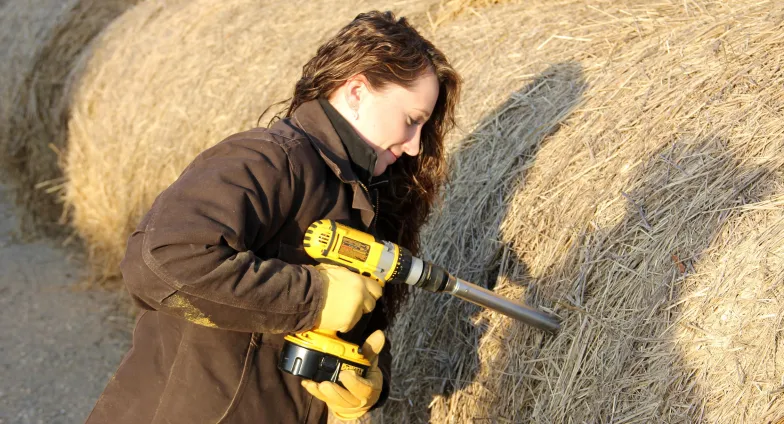Sampling Feeds and Testing for Nutritional Value
The best way to use your feed resources is to know what quality you have, then match the feed to the cattle’s production stage. Or stated another way, keep the good hay for calving time and feed the rest now. We usually think the early cut, no-rain hay is the best quality. And it usually is. However, I sample quite a few feeds and I have observed enough year-to-year, hay pile-to-hay pile variation that feed testing is vital to find the good hay.
Protein and energy contents change. I see a lot of hays that producers put up, expecting adequate crude protein content, but the crude protein was only marginal. Energy content also can be disappointing. Consequently, testing feeds and supplementing with purchased feeds or mixing with better feeds or hays is usually the most cost-effective route. Otherwise, cows will lose weight and calves will gain poorly.
Here is what you need to know when testing feed:
- How to feed test: The first rule to remember in sampling feeds for testing is to take a representative sample. If you only sample bales from the good side of the field, then you will have a report for only good hay. The second rule is to make sure you get the representative sample into the sample bag/container. The challenge of getting a sample of mixed feed into a small sample bag is keeping in the fines (alfalfa leaves, ground feed, minerals) from getting into the bag.
- Have the right tools: A coring probe will provide a more accurate sample than a “hand-grab”sample. Several probes are available, and all have advantages and disadvantages. I use the Penn State Forage Sampler probe. It has a sharp cutting tip that is replaceable. Combining the probe with an 18-volt DeWalt drill makes a sampling machine that can probe hay bales quickly and easily. While I expect many places sell the Penn State Forage Sampler, I have found it at www.enasco.com/product/C06541HV. A listing of other probes can be found at www.foragetesting.org/index.php?page=hay_probes.
- Having a sharp cutting tip, as well as power to drill into the feed source, is essential. I remember using a brace and bit drill and I understand why forage sampling and testing didn’t get done before the widespread use of heavy-duty portable electric drills.
- How many to sample: Sampling every bale is best but not practical. Class the feeds according to type, cutting, field and sample (for example, first-cut alfalfa hay, south field). Then core representative bales and empty the samples into the sample container. Core at least seven bales, but 20 bales would be better. Hand-grab samples will not be representative unless the feed already is well-mixed before sampling.
- Send the feed to a feed testing laboratory: The National Forage Testing Association has a list of certified labs at www.foragetesting.org/index.php?page=certified_labs.
- What to test for: Feeds can be tested for many things. The most important tests for ration balancing are dry matter, crude protein, acid detergent fiber (for determining energy content), calcium, phosphorous, magnesium, potassium and sulfur. You can choose either NIRS (near-infrared spectrophotometry) or wet chemistry methods. I tend to choose the wet chemistry method for the wide variety of feeds that I sample. The cost is $10 to $20 per sample, depending on the tests selected.
